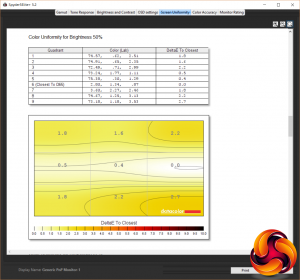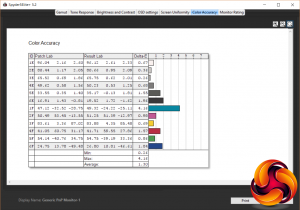Acer Predator XB321HK Analysis
We start our assessment of all monitors with an objective test of its out-of-the-box image quality, using a DataColor Spyder Elite colorimeter. This is a device that sits in the middle of the display and measures its output, checking for things like maximum brightness and colour accuracy.
In its out of the box state, the XB321HK is set to brightness 80 with gamma in the first of its settings, contrast at 50 and the Warm colour preset used. Aside from it being a bit bright, this results in very good overall image quality straight away.
The first test that the colorimeter performs checks for how much of the various standard colour spaces the monitor can cover. It managed 100% of the sRGB colour space and 79% of the AdobeRGB space, which is as good as you can hope for from a display of this type.
Less impressive is brightness uniformity, with this varying by an average of 8.6%, and peaking at 16%. This is not a great showing but for such a large screen it’s largely forgivable and certainly isn’t bad enough that it was at all noticeable to the naked eye in general use.
Much more impressive is colour uniformity with this straying by only 1.8% and peaking at just 3.7 %. This is an excellent result that means colours look consistent right the way across the screen.
As for different brightness settings on the OSD, at 100% the XB321HK kicks out 316nits, which is a touch below the 350nits claimed by Acer but still plenty to get by. Meanwhile, at 0/100 on the brightness scale the monitor emit 50nits. Overall, there’s a decent range of brightness options on offer that means you should be able to fine tune the display to the brightness you like.
Another impressive result is contrast. The Spyder5 tends to slightly under report contrast levels so a showing of 880:1 is very good and in line with the 1000:1 claims of Acer. As usual we see contrast being reported as far to high at the lowest brightness setting. This is a bug of the software and should be ignored.
Given how well the XB321HK has done so far we were a little surprised to find its two gamma settings weren’t all that accurate. The 2.2 setting actually turned out to be 2.3 and the 1.8 setting was 2.0. Neither is so bad as to ruin the display’s performance in any significant way but it’s a shame these figures aren’t closer to what they should be.
Things are back on form when it comes to colour accuracy, though, as a average Delta E of 1.3 is excellent. Anything below three is considered to represent an all but imperceptible difference in colour, so even the peak or 4.16 is very good.
Finally, cycling through the monitor’s umpteen different colour modes, we see that the default Warm colour setting is reasonably close to the desired 6500K colour temperature (white point), as is the User colour option. Choose the Eco mode and brightness drops significantly and the colour temperature drops a bit while the Cool colour option drops the contrast and has frankly ridiculous colour temp of 11300K.
The various eColor modes – graphics, movie, standard, eco – don’t entirely convince in terms of their necessity but one thing’s for sure, which is that this display has all the options you’ll ever need to get the best image quality from it.
Perhaps more importantly, though, is that although not perfect, image quality is good enough that most users will be happy enough to use the monitor exactly as it arrives. If you do want to calibrate this display, though, then you can get even better results.
Switching to the User colour mode, we tweaked the RGB channels from 100x100x100 to 100x100x94 and this nudged the colour temperature so it was bang-on the ideal of 6500K. That’s all that was required, though – everything else was left in its default state. The final tweaks were done in using the Spyder5 calibration software, but this only made very small changes.
After changing these settings and running the Spyder5 calibration the colour temperature was perfect plus colour accuracy improved too, with a Delta E of just 0.93.

Surprisingly, though, even after calibration, the gamma settings were still a little bit out, with neither setting improving upon its pre-calibration performance. Contrast also dropped slightly but not enough to cause concern.
So, all in all, in terms of colour accuracy and raw image-performance, this display is excellent both before and after calibration. This is always important but it’s doubly so when paying such a premium for a 4K screen like this.
As for other image quality factors, viewing angles are as good as you’d expect for an IPS panel and although there is the usual IPS glow, it’s not as bad as we’ve seen on some displays. The worst area is the bottom right corner where you can notice a slight glow even when viewed straight on. But, as with all complaints of IPS glow, this is only really noticeable if you look for it.
When it comes to gaming, the 60Hz limitation means this is not ideal for competitive gaming but its 4ms response time and sub 10ms input lag means it’s okay for more casual playing. Moreover, for single-player games the combination of a 4K resolution, G-Sync and the fantastic image quality makes for some jaw-dropping visuals.
The Acer XB321HK is one of the finest 4K monitors you can buy. Its combination of a larger 32-inch size with that 4K resolution means it’s much more practical than smaller screens with the same resolution.
Add in fantastic overall image quality and you’ve got a display that’s superb for work and play alike. Being stuck at 60Hz means it’s never going to be your first choice for competitive gaming but for everything else it is superb.

Even the fact you’re paying a premium for G-Sync feels less of a hindrance here as the cost is that much lower proportional to the overall cost of the display, and because the rest of the display is so good it doesn’t feel like you’re paying that premium while missing out elsewhere.
In fact, the only significant reason not to get this monitor is that in a few months time we’ll finally be getting 4K displays that can refresh at higher rates. They’ll only be 27-inch but if you want that competitive gaming performance, you may want to wait. Otherwise, this XB321HK comes highly recommended.
Pros:
- Fantastic image quality.
- Larger size and 4K is perfect combo.
- Decent gaming performance.
Cons:
- Stand doesn’t pivot or rotate.
- Design isn’t for everyone.
- Expensive.
Kiguru Says: Not one for competitive gamers but for everyone else this is one of the finest monitors you can buy.
 KitGuru KitGuru.net – Tech News | Hardware News | Hardware Reviews | IOS | Mobile | Gaming | Graphics Cards
KitGuru KitGuru.net – Tech News | Hardware News | Hardware Reviews | IOS | Mobile | Gaming | Graphics Cards





















When playing in lower resolutions other monitors seem to be able to play at higher fps. Is this one capped at 60hz even in say 1080p?
60hz should be the maximum vertical frequency of that panel. You can’ t go any higher even at lower res.
https://www.displayspecifications.com/en/model/336a702